Arc Grounding Fault Monitoring and Fire Prediction Method Based on EEMD and Reconstruction
Abstract
:1. Introduction
- Through monitoring the residual current, the EEMD is used to decompose the current, calculate the entropy of the IMF component and reconstruct it, remove the redundant information, and analyze the difference between the fault line and the normal line according to the reconstructed signal.
- Residual current is selected as the input of BPNN and applied to fire probability prediction. Aiming at the problems of slow convergence speed and easily falling into the optimal local value of the BP algorithm, the BAS algorithm is proposed to optimize the weight and threshold of BPNN.
- Simulation verification. The fault line is judged by analyzing the reconstructed signal’s characteristics. BAS-BP is compared with BPNN, and the model’s performance is evaluated according to the probability of fire occurrence.
2. Residual Current Monitoring
3. Research on AC Power Ground Fault in Substations
3.1. Station AC Power Ground Fault Intelligent Sensing Technology
3.2. EEMD
- Identify all maxima and minima and fit their envelopes, eup(t) and elow(t), and calculate the average value of the upper and lower envelopes m1(t).
- The IMF component c1(t) is removed from the original signal to extract the residual component,
- Add a random Gaussian white noise sequence to the target signal:
- 2.
- Decomposition of the signal using EMD to obtain n IMF components and 1 RES component.
- 3.
- Repeat the above steps by adding a different sequence of white noise each time.
- 4.
- Using the characteristic that the white noise spectrum has zero mean, the above components are averaged to obtain the final decomposition results as follows:where: N is the number of times white noise is added; ci(t) is the i-th IMF component after integrated averaging; and r(t) is the final residual component.
3.3. SE
- Time series form the series into an m-dimensional vector according to the ordinal number:
- Ascertain distance between the vectors X(i) and X(j); is the absolute value of the maximum difference between the two corresponding elements.
- Given the similarity tolerance r, for each value of the i statistics number of , denoted as Bm(i), calculate the ratio to a total number of distances N-m, denoted as . Definition:
- Find the average of all and denote as , then
- Update m to m + 1 and repeat the above steps, noting as
- SE is
4. Substation Fire Warning Method Research
4.1. Establishing Input and Output Relationships
4.2. BAS Algorithm
- Set up random variables and normalize them:
- 2.
- Create spatial coordinates:
- 3.
- Location update:
4.3. Optimized Prediction Model Based on BAS-BPNN Algorithm
- Random vectors of beetle antennae are created and normalized;
- The left and right spatial coordinates of longicorn whiskers are obtained. According to the fitness function f(x), determine the strength of the food odor be obtained from the left and right, judge the moving direction of the longicorn beetle, and update the position of the longicorn beetle;
- Select step factor δt. It is mainly used to control the area search ability of beetles; select a more significant value as much as possible to avoid falling into local optimization. The step factor changes dynamically with time;
- 4.
- Assuming the initial value, calculate the fitness function value, and store the current initial position of the bestX and the corresponding fitness function value bestY;
- 5.
- Calculate the length of beetle antennae and build a search space. The position of beetle antennae that must receive information updates through beetle antennae, the fitness function, calculates the second fitness function value, compares it with bestY, determines the current optimal fitness value, and saves the corresponding weight as the current optimal weight;
- 6.
- Test the termination condition of the algorithm. If the conditions are met, the algorithm will jump out. Otherwise, a new round of optimization will be carried out. Figure 3 is the flow chart of the BAS-BP algorithm.
5. Case Study
5.1. Grounding Fault Simulation Analysis
5.2. Substation Fire Probability Prediction
6. Conclusions
Author Contributions
Funding
Conflicts of Interest
References
- Zhang, Z.Y.; Wang, Z.Y.; Kang, C.; Yu, F.; Ma, Z.X.; Gou, J. Research on overvoltage characteristics and influencing factors of converter station under grounding fault. Energy Rep. 2022, 8, 445–454. [Google Scholar] [CrossRef]
- Salvadori, F.; Gehrke, C.S.; Hartmann, L.V.; Freitas, I.S.; Santos, T.d.S.; Texeira, T.A. Design and implementation of a flexible intelligent electronic device for smart grid applications. In Proceedings of the 2017 IEEE Industry Applications Society Annual Meeting, Cincinnati, OH, USA, 1–5 October 2017; pp. 1–6. [Google Scholar]
- Courty, L.; Garo, J.P. External heating of electrical cables and auto-ignition investigation. J. Hazard. Mater. 2017, 321, 528–536. [Google Scholar] [CrossRef] [PubMed]
- Liang, X.M.; Zhang, P.; Chang, Y. Recent advances in high-voltage direct-current power transmission and its developing potential. Power Syst. Technol. 2012, 36, 1–9. [Google Scholar]
- Park, D.; Kim, I.; Choi, S.; Kil, G. Detection algorithm of series arc for electrical fire prediction. In Proceedings of the 2008 International Conference on Condition Monitoring and Diagnosis, Beijing, China, 21–24 April 2008; pp. 716–719. [Google Scholar]
- Zhao, J.W.; Lou, J.N.; Sun, J.; Feng, Z.X.; Li, P.; Gao, M.M. A new method for faulty line selection in distribution systems based on wavelet packet decomposition and signal distance. In Proceedings of the 2019 IEEE 8th International Conference on Advanced Power System Automation and Protection, Xi’an, China, 21–24 October 2019; pp. 596–600. [Google Scholar]
- Perveen, R.; Mohanty, S.R.; Kishor, N. Fault location in VSC-HVDC section for grid integrated offshore wind farm by EMD. In Proceedings of the 2016 18th Mediterranean Electrotechnical Conference, Lemesos, Cyprus, 18–20 April 2016; pp. 1–5. [Google Scholar]
- Zhang, G.D.; Zhou, H.M.; Wang, C.J.; Xue, H.Z.; Wang, J.D.; Wan, H.W. Forecasting time series albedo using NARnet based on EEMD decomposition. IEEE Trans. Geosci. Remote Sens. 2020, 58, 3544–3557. [Google Scholar] [CrossRef]
- Gao, K.P.; Xu, X.X.; Li, J.B.; Jiao, S.J.; Shi, N. Weak fault feature extraction for polycrystalline diamond compact bit based on ensemble empirical mode decomposition and adaptive stochastic resonance. Measurement 2021, 178, 109304. [Google Scholar] [CrossRef]
- Xue, S.Z.; Cheng, X.G.; Lv, Y.X. High resistance fault location of distribution network based on EEMD. In Proceedings of the 2017 9th International Conference on Intelligent Human-Machine Systems and Cybernetics, Hangzhou, China, 26–27 August 2017; pp. 322–326. [Google Scholar]
- Yun, Y. Situation Prediction of Fire Management System Based on BP Neural Network. In Proceedings of the 2021 11th International Conference on Information Technology in Medicine and Education, Wuyishan, China, 19–21 November 2021; pp. 174–179. [Google Scholar]
- Zhang, W. Electric fire early warning system of gymnasium building based on multi-sensor data fusion technology. In Proceedings of the 2021 International Conference on Machine Learning and Intelligent Systems Engineering, Chongqing, China, 9–11 July 2021; pp. 339–343. [Google Scholar]
- Chen, L.; Wang, Y.Q. Research on the material fire risk index based on the GA-BP neural network. In Proceedings of the 2021 International Conference on Advances in Optics and Computational Sciences, Ottawa, OT, Canada, 21–23 January 2021; pp. 1–6. [Google Scholar]
- Zhang, Y.X.; Cui, N.B.; Feng, Y.; Gong, D.Z.; Hu, X.T. Comparison of BP, PSO-BP and statistical models for predicting daily global solar radiation in arid Northwest China. Comput. Electron. Agric. 2019, 164, 104905. [Google Scholar] [CrossRef]
- Ye, Z.X.; Yun, L.J.; Wang, Y.B. Prediction of storage tobacco mildew based on BP neural network optimized by beetle antennae search algorithm. In Proceedings of the 2020 Chinese Control and Decision Conference, Hefei, China, 22–24 August 2020; pp. 4473–4477. [Google Scholar]
- Jiang, X.Y.; Li, S. BAS: Beetle antennae search algorithm for optimization problems. Int. J. Robot. Control. 2018, 1, 1–5. [Google Scholar] [CrossRef]
- Li, X.Q.; Jiang, H.K.; Niu, M.G.; Wang, R.X. An enhanced selective ensemble deep learning method for rolling bearing fault diagnosis with beetle antennae search algorithm. Mech. Syst. Signal Process. 2020, 142, 106752. [Google Scholar] [CrossRef]
- Xu, Y.; Huang, Y.M.; Ma, G.W. A beetle antennae search improved BP neural network model for predicting multi-factor-based gas explosion pressures. J. Loss Prev. Process Ind. 2020, 65, 104117. [Google Scholar] [CrossRef]
- Freschi, F. High-frequency behavior of residual current devices. IEEE Trans. Power Deliv. 2012, 27, 1629–1635. [Google Scholar] [CrossRef] [Green Version]
- Yue, D.W.; Li, K.; Yuan, J.L.; Zhang, G.Y. Residual current monitoring based on DeviceNet. In Proceedings of the 2008 7th World Congress on Intelligent Control and Automation, Chongqing, China, 25–27 June 2008; pp. 6027–6030. [Google Scholar]
- Diao, J.X.; Hu, H.D. Study on Residual Current Monitoring System for Detection. In Proceedings of the Applied Mechanics and Materials, Zhuhai, China, 8–9 March 2014; pp. 1101–1104. [Google Scholar]
- Gaci, S. A new ensemble empirical mode decomposition (EEMD) denoising method for seismic signals. Energy Procedia 2016, 97, 84–91. [Google Scholar] [CrossRef] [Green Version]
- Jiang, H.K.; Li, C.L.; Li, H.X. An improved EEMD with multiwavelet packet for rotating machinery multi-fault diagnosis. Mech. Syst. Signal Process. 2013, 36, 225–239. [Google Scholar] [CrossRef]
- Richman, J.S.; Moorman, J.R. Physiological time-series analysis using approximate entropy and sample entropy. Am. J. Physiol.-Heart Circ. Physiol. 2000, 278, H2039–H2049. [Google Scholar] [CrossRef] [PubMed] [Green Version]
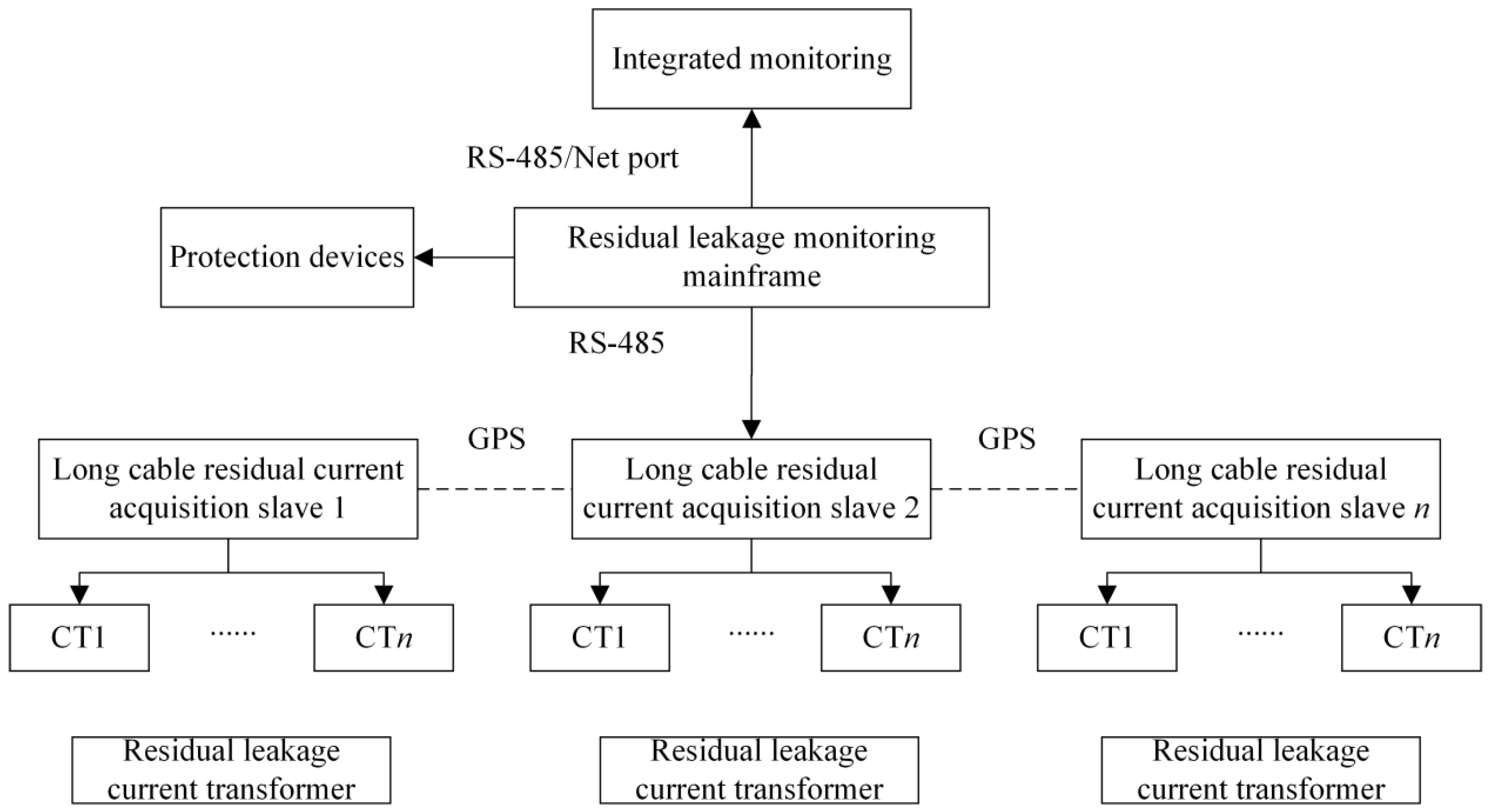
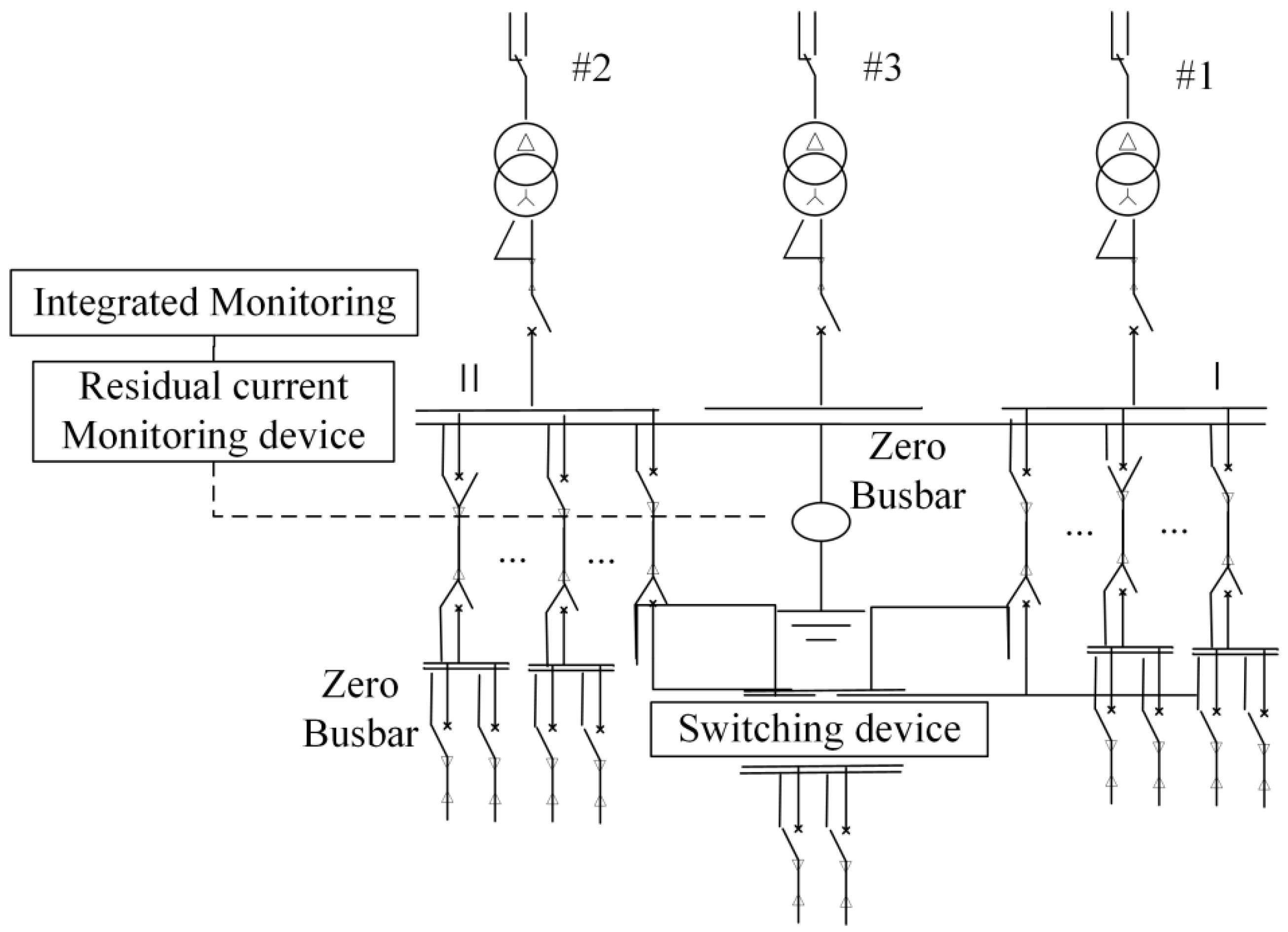
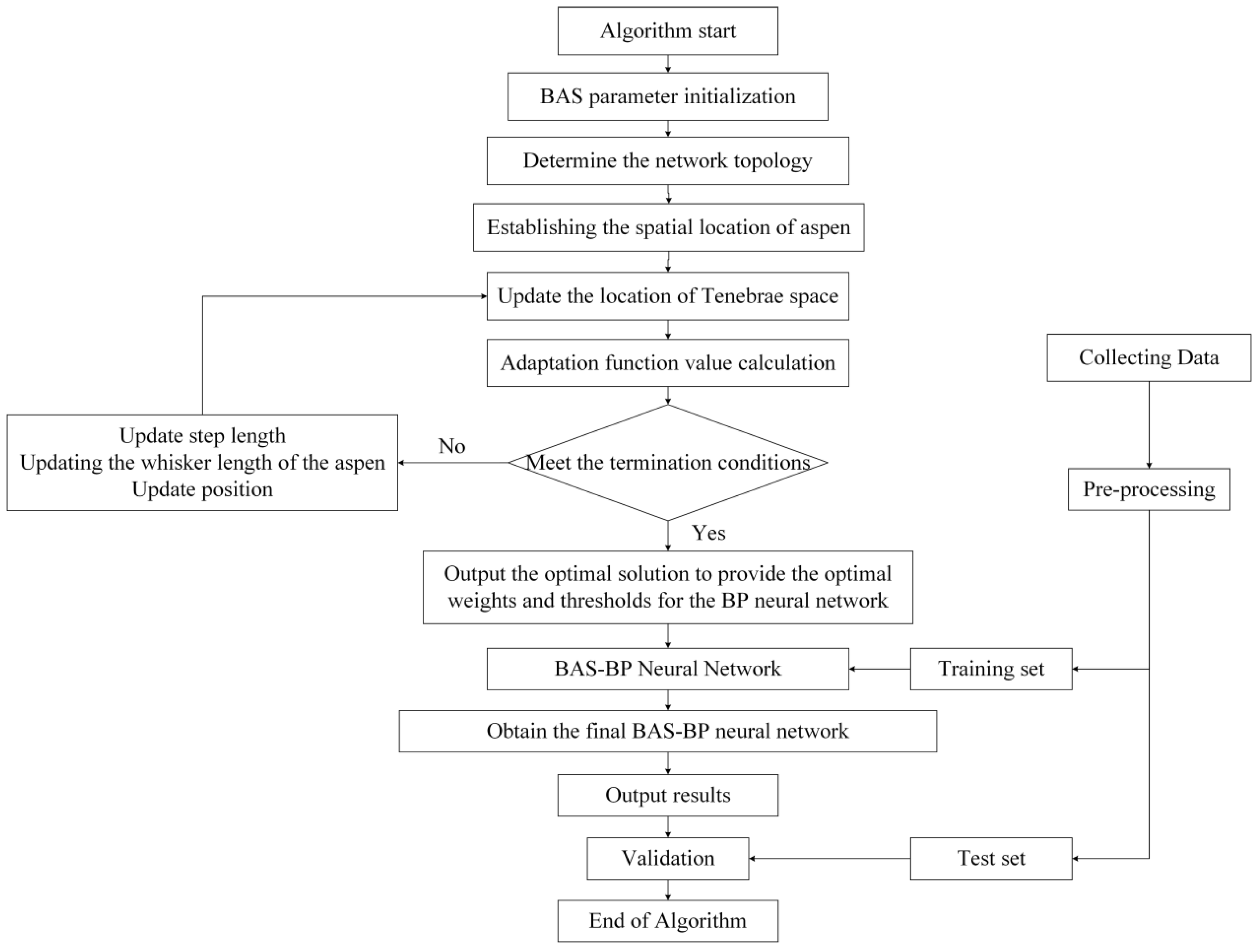
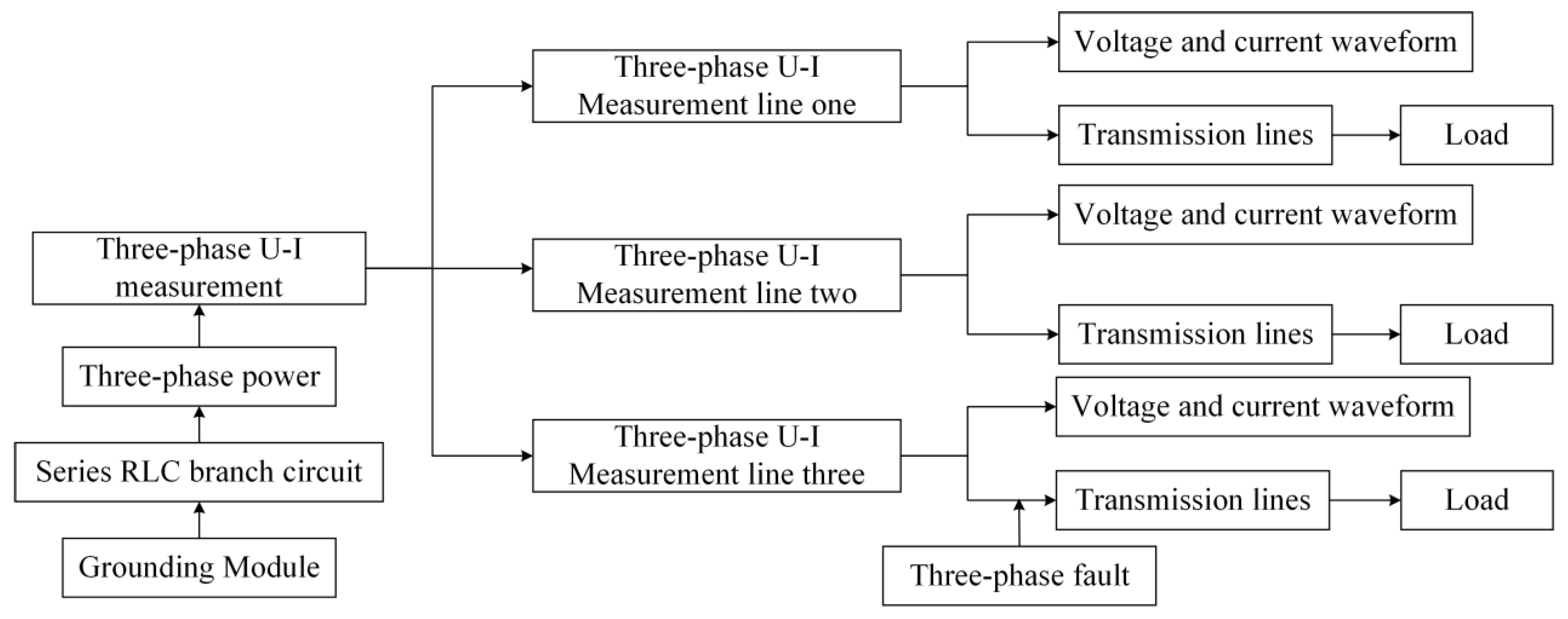
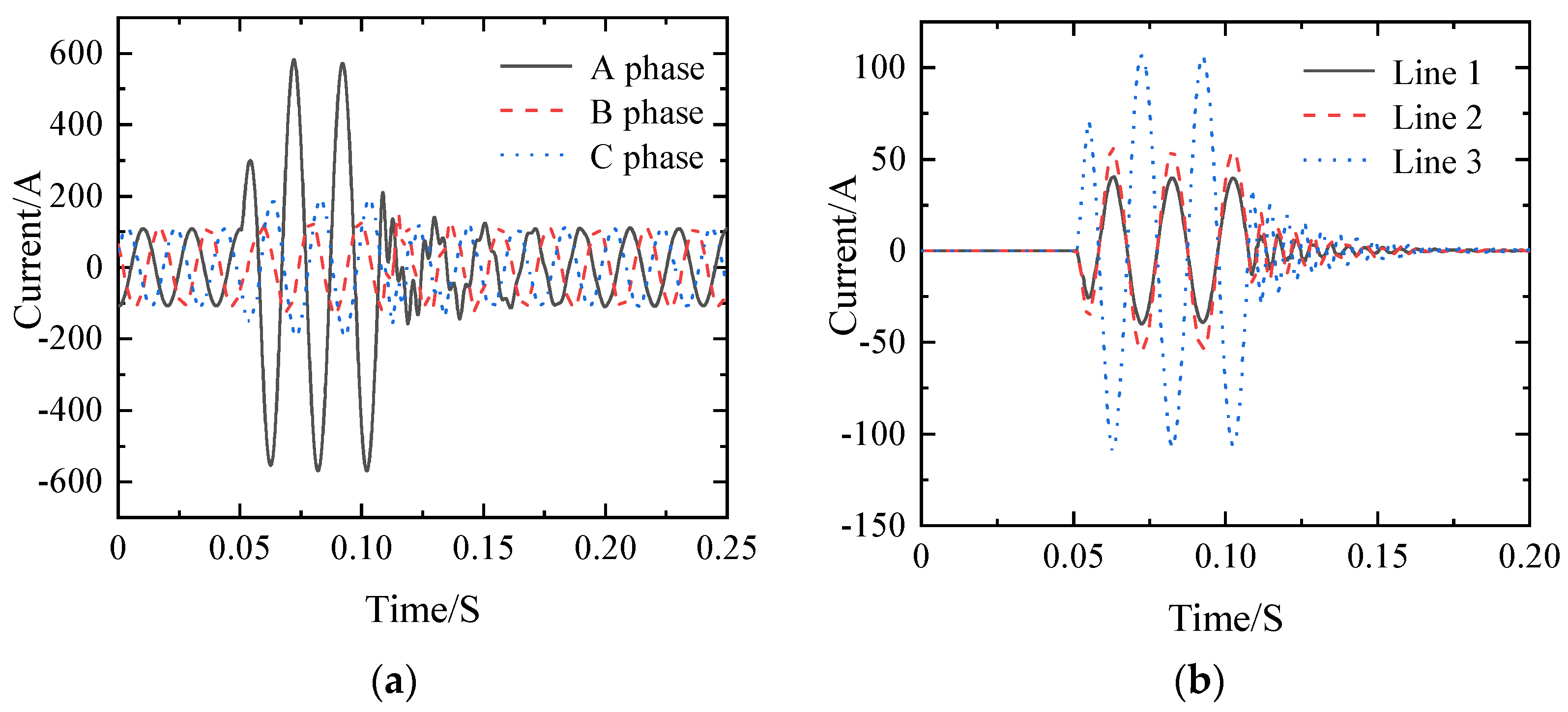
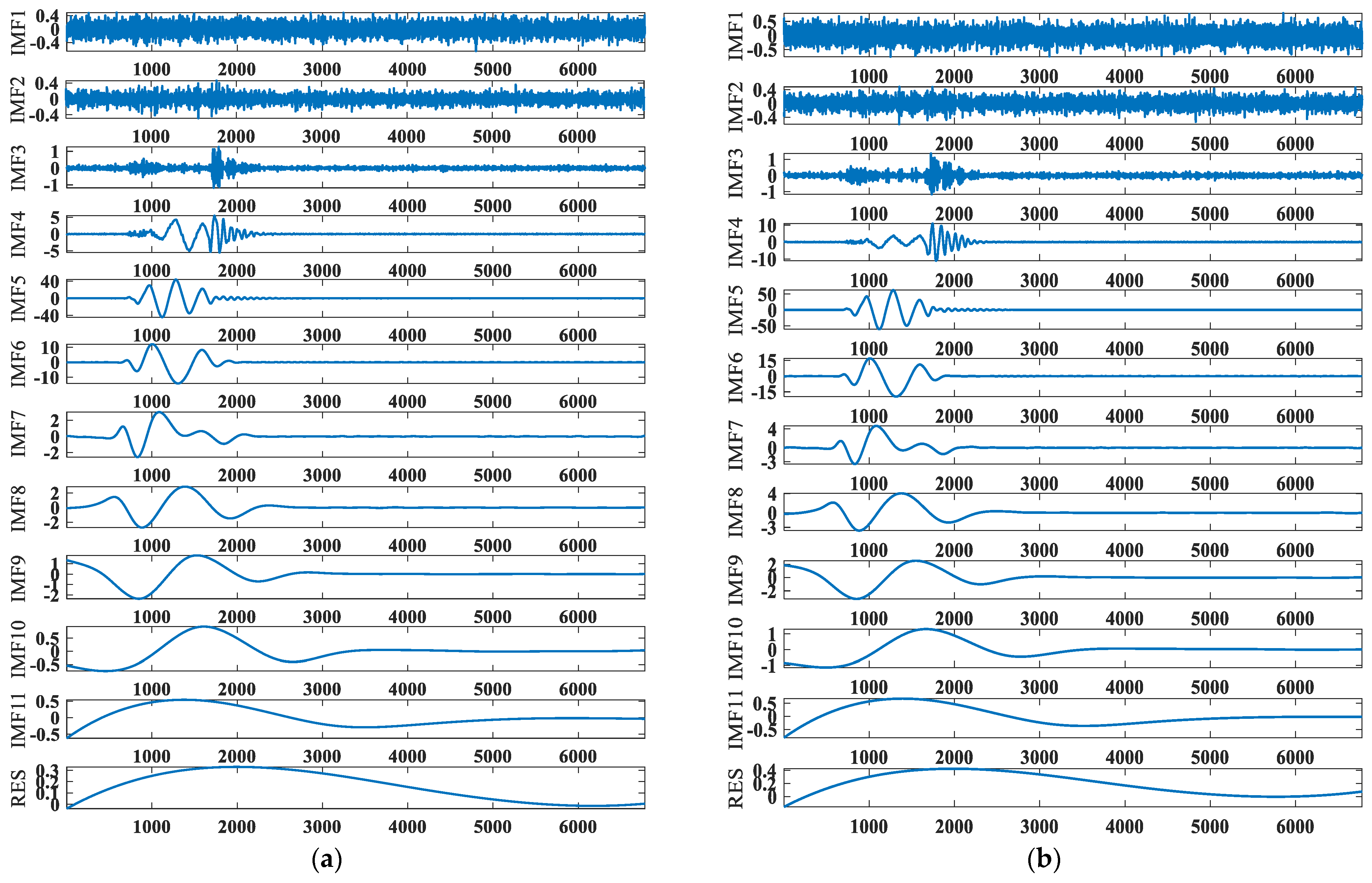






| IMF1 | IMF2 | IMF3 | IMF4 | IMF5 | IMF6 | IMF7 | IMF8 | IMF9 | IMF10 | IMF11 | RES | |
|---|---|---|---|---|---|---|---|---|---|---|---|---|
| Line 1 | 2.0726 | 1.4908 | 0.5703 | 0.0154 | 0.0068 | 0.0027 | 0.0032 | 0.0025 | 0.0021 | 0.0014 | 0.0025 | 0.0018 |
| Line 2 | 2.0682 | 1.5051 | 0.5863 | 0.0128 | 0.0070 | 0.0023 | 0.0032 | 0.0025 | 0.0019 | 0.0015 | 0.0025 | 0.0022 |
| Line 3 | 2.0638 | 1.4853 | 0.6760 | 0.0098 | 0.0053 | 0.0024 | 0.0039 | 0.0026 | 0.0017 | 0.0015 | 0.0026 | 0.0021 |
| Algorithm | RMSE | MAPE/% | ||||
|---|---|---|---|---|---|---|
| No Fire | Smolder | Open Flame | No Fire | Smolder | Open Flame | |
| BP | 0.046 | 0.034 | 0.036 | 7.7 | 11.1 | 13.5 |
| BAS-BP | 0.021 | 0.020 | 0.032 | 4.8 | 8.53 | 10.8 |
Publisher’s Note: MDPI stays neutral with regard to jurisdictional claims in published maps and institutional affiliations. |
© 2022 by the authors. Licensee MDPI, Basel, Switzerland. This article is an open access article distributed under the terms and conditions of the Creative Commons Attribution (CC BY) license (https://creativecommons.org/licenses/by/4.0/).
Share and Cite
Li, B.; Du, X.; Miao, J.; Wang, H.; Ma, Y.; Li, Z. Arc Grounding Fault Monitoring and Fire Prediction Method Based on EEMD and Reconstruction. Electronics 2022, 11, 2159. https://doi.org/10.3390/electronics11142159
Li B, Du X, Miao J, Wang H, Ma Y, Li Z. Arc Grounding Fault Monitoring and Fire Prediction Method Based on EEMD and Reconstruction. Electronics. 2022; 11(14):2159. https://doi.org/10.3390/electronics11142159
Chicago/Turabian StyleLi, Bingyu, Xuhao Du, Junjie Miao, Haobin Wang, Yanqiang Ma, and Zheng Li. 2022. "Arc Grounding Fault Monitoring and Fire Prediction Method Based on EEMD and Reconstruction" Electronics 11, no. 14: 2159. https://doi.org/10.3390/electronics11142159
APA StyleLi, B., Du, X., Miao, J., Wang, H., Ma, Y., & Li, Z. (2022). Arc Grounding Fault Monitoring and Fire Prediction Method Based on EEMD and Reconstruction. Electronics, 11(14), 2159. https://doi.org/10.3390/electronics11142159






